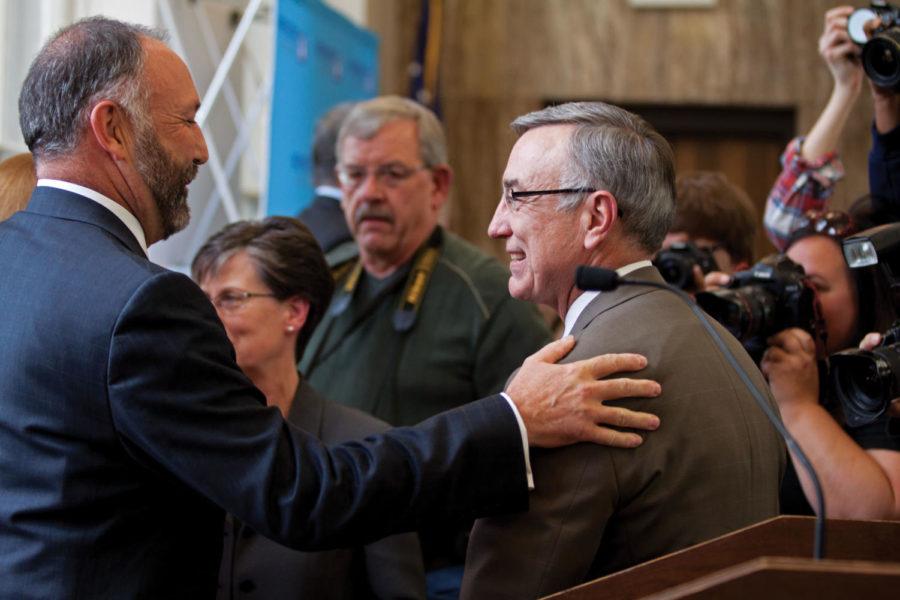Athletics: New president, similar philosophy
Current ISU President Gregory Geoffroy and president-elect Steven Leath speak to each other after the announcement ceremony on Tuesday, Sept. 27, in the Campanile Room of the Memorial Union. Leath said he looks forward to working with Geoffroy in the transition.
September 27, 2011
ISU Athletic Director Jamie Pollard said that outgoing ISU President Gregory Geoffroy will be missed when he steps down after a decade at the helm of the university.
For the past 10 years, the ISU athletics department has received strong support from the man at the top of the university. Now, Geoffroy is ending his tenure, and the athletic department must look ahead to building a relationship with a new leader — one who will fill the shoes of a person Pollard described as the perfect fit.
“[Geoffroy’s] leadership style was perfect for Iowa State’s athletics program,” Pollard said. “He’s very supportive, very knowledgeable of athletics and he understands where athletics fits for the campus in terms of outreach and image.”
Since arriving at Iowa State in 2001, Geoffroy has been involved with the athletics program. Geoffroy said he views the athletic department as an integral part of the university, providing both a public image and a quality student life.
“A successful athletics department is important for the university because it positively affects student recruitment, alumni loyalty and giving to the institution and it enhances the general perception of the university from the public,” Geoffroy said. “It also benefits the students by creating a vibrant campus.”
In 2005, Geoffroy hired Pollard as the athletic director and the two have worked together since to move athletics forward.
Upon the completion of the Cyclones Sports Complex and Football Training Facility in the fall of 2012, the department will have invested $100 million in facility construction and renovations since Pollard and Geoffroy were paired.
Pollard said Geoffroy was invaluable in the completion of the Sukup Basketball Complex and said it was his “nimbleness” that helped the athletics department work around hurdles that tried to prevent the project from taking place.
Geoffroy also played a strong role with renovations to Jack Trice Stadium, the plans for the Cyclone Sports Complex, the turning over of Hilton Coliseum to the athletic department and the Hixson-Lied Academic Center, which helped ISU student-athletes achieve a 79 percent graduation rate in 2010, the seventh-best in the nation.
Even without the most resources, Iowa State has progressed.
“We’ll never be the biggest and we’ll never be the most well-funded,” Pollard said. “But if you have the right people and you give them the ability to do their jobs, then we’ve got a fighting chance — and that’s all we can ask for.”
For Geoffroy, taking a role in athletics from the beginning has been important, but so too has been giving Pollard and his department room to work.
“I believe it is very important for the university president to support intercollegiate athletics,” Geoffroy said. “But it’s also very important to have a very top-notch athletics director — as we do — to oversee the department.”
For Pollard, Geoffroy’s role has been perfect.
“There’s an old saying that says, ‘You want a president that understands athletics and is supportive, but that doesn’t want to be the athletics director,'” Pollard said. “He had the right balance.”
In March, Geoffroy announced that he would step down as president of the university no later than July 2012. On Tuesday, the Iowa Board of Regents announced Steven Leath will be the university’s 15th president.
Pollard and his department will now begin work with a new leader. But Leath, as Geoffroy has, views athletics as an immense part of the university.
“Athletics is really the front door to the university,” Leath said. “[The public’s] initial impression of the university is seen through athletics.”
Leath said he also believes athletics enhance the student experience.
“I think it’s hard for many students to have the full campus life experience without a vibrant athletics program,” Leath said. “And a winning one makes it much more enjoyable.”
Leath feels the president and athletic director must have good communication and said the president is ultimately responsible for everything, both good and bad.
However, Leath feels Geoffroy has already laid good groundwork.
“One role of the president, in my opinion, is to recruit and retain the athletics director. I think President Geoffroy has done a great job and has a great athletics director,” Leath said. “My job would be to keep him here.”
Pollard just hopes that Leath can enjoy athletics.
“One of the things that Dr. Geoffroy did really well was — although he was president — he was in the crowd enjoying it,” Pollard said. “My hope for [Leath] would be that he’s able to feel comfortable enough to be able to enjoy it as well.”







